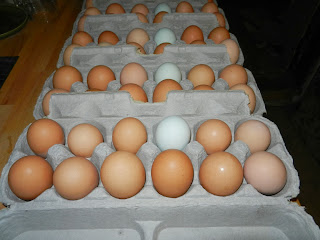Every year we try to add a few trees to our small orchard in the hope that one day we will be able to eat homegrown fruit along with our homegrown vegetables. Last year we harvested our first peaches - 1 each - and we just knew this year was going to be wonderful! The cool wet spring had us worrying about late frosts that might kill the tender blossoms, but no, they held on. We watched the pollinators do their work - small native bees for the most part. We saw tiny fruitlets form behind the blossoms and then, real fruit! Very small at first, but lots of them and they grew quite large. I annoyed everyone by singing "gonna eat a lot of peaches" every time I set foot in the orchard. We made daily reports: "might be ripe next week", "looking good, but still not quite ready", "one is turning a little bit orange", "the peaches are all gone" - WHAT??!
Yep, there was not a single peach on the trees and all the pears (that we had been excited about too, but lets face it, they aren't peaches). There was just one tiny tree, a mistake, with a few peaches on it. It began life as a "patio peach" but died back years ago and then sprouted up from its unknown (but peachy) rootstock. It grows at a 60° angle and tends to be ignored - by the thief as well as by us apparently. I guarded that tree, it was our last hope.
Squirrels! I was sure they were responsible for this affront. What else could climb the trees and steal unripe fruit? The deer damage the branches, but I couldn't imagine them gently plucking off an unripe peach and leaving the yummy foliage behind. It had to be squirrels. But how do you stop squirrels?
It turns out we did not need to learn about effective squirrel deterrents - they were innocent. Well, maybe only partially guilty. The truly guilty party would have managed to avoid all suspicion if he could have just resisted the mistake peaches.
I came outside from lunch, heading for the field when, in my peripheral vision, I saw movement at the mistake peach tree. I couldn't believe my eyes. I needed a camera for this. Too late, he got away.
What I had seen was a very large, wobbly bottomed creature sort of flomping his way backwards down the very skinny trunk of the mistake peach tree. It didn't seem possible. It defied gravity. But I saw it. A woodchuck. A ground hog. A whistle pig. We instantly named him fat boy and although I did not get a photo of him, I did manage to follow his trail of peach pits through the woods to his home!
Woodchucks don't care too much about hiding the entrance to their dens. They excavate huge amounts of soil and just sort of spread it around.
A close up. The entrance hole is about the shape of his wobbly body.
Here's the part he didn't want us to see. The entrance is big and showy, but the escape route is much smaller and quite well hidden.







































